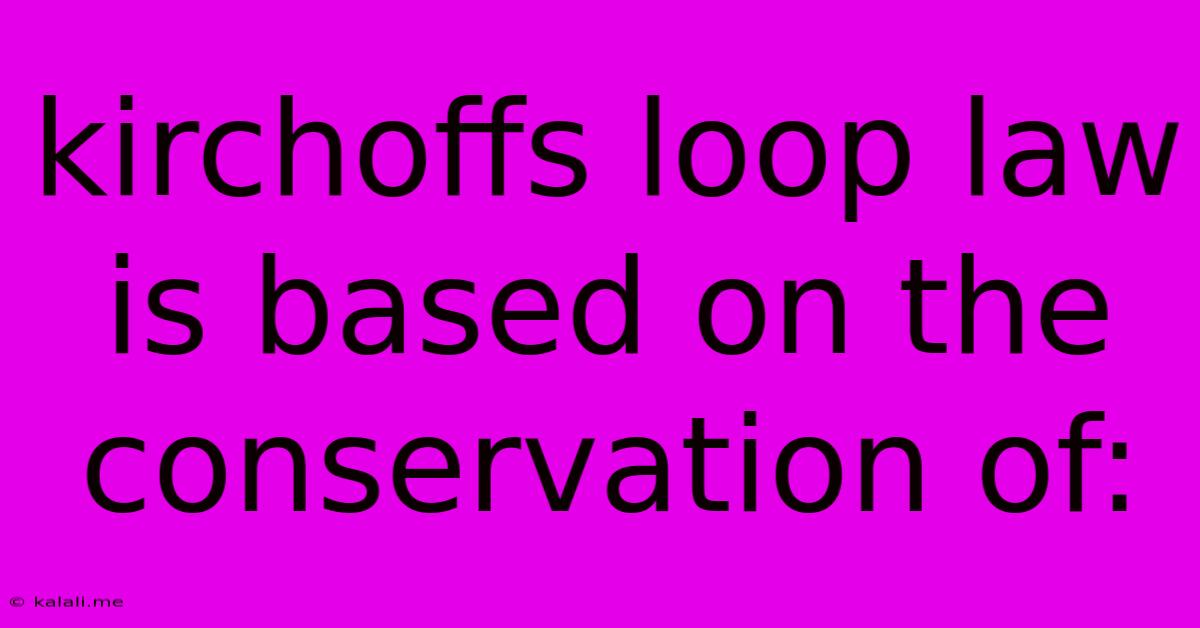Kirchoffs Loop Law Is Based On The Conservation Of:
Kalali
Jun 01, 2025 · 3 min read

Table of Contents
Kirchhoff's Loop Law: Based on the Conservation of Energy
Kirchhoff's Loop Law, also known as Kirchhoff's Voltage Law (KVL), is a fundamental principle in electrical circuit analysis. It's a powerful tool used to analyze complex circuits and solve for unknown voltages and currents. Understanding its basis in a fundamental conservation principle is key to mastering its application. This article will delve into the core concept: Kirchhoff's Loop Law is based on the conservation of energy.
What is Kirchhoff's Loop Law?
Simply put, Kirchhoff's Loop Law states that the sum of the voltage drops around any closed loop in a circuit is equal to zero. This means that as you trace a path around a complete circuit loop, the total increase in electric potential is zero. This holds true regardless of the complexity of the circuit.
The Connection to Conservation of Energy
The law's foundation lies in the principle of conservation of energy. Energy cannot be created or destroyed, only transformed from one form to another. In an electrical circuit, energy is transformed between electrical potential energy and other forms of energy, such as heat (in resistors) or electromagnetic energy (in inductors and capacitors).
Consider a simple circuit with a battery and a resistor. The battery provides electrical potential energy to the electrons. As these electrons flow through the resistor, this potential energy is converted into heat due to the resistance. Kirchhoff's Loop Law accounts for this energy transformation. The voltage rise across the battery (positive) is exactly balanced by the voltage drop across the resistor (negative). The net change in potential energy around the loop is zero, reflecting the conservation of energy.
Analyzing Complex Circuits with Kirchhoff's Loop Law
The power of Kirchhoff's Loop Law becomes evident when analyzing more intricate circuits containing multiple loops and components. By applying the law to each independent loop, we can create a system of equations that allows us to solve for unknown voltages or currents.
For example, in a circuit with multiple resistors and voltage sources, each loop will have its own equation based on KVL. Solving these simultaneous equations reveals the voltage across each component and the current flowing through each branch. This process relies entirely on the principle that the net change in energy around each loop must be zero.
Kirchhoff's Current Law (KCL) and the Conservation of Charge
While we've focused on KVL and energy, it's important to mention Kirchhoff's Current Law (KCL). KCL states that the sum of currents entering a junction (node) equals the sum of currents leaving that junction. This, in turn, is based on the conservation of charge. Charge, like energy, cannot be created or destroyed; it's simply redistributed within the circuit.
In Conclusion
Kirchhoff's Loop Law is a cornerstone of circuit analysis, deeply rooted in the fundamental principle of conservation of energy. Understanding this relationship provides a clearer and more intuitive grasp of how the law works and how it can be applied to solve even the most complex circuit problems. By recognizing the energy transformations within the circuit and applying KVL correctly, engineers and scientists can effectively analyze and design electrical systems.
Latest Posts
Latest Posts
-
How To Plug Big Wholes With Waterproffing
Jun 03, 2025
-
Was Does Having The Bcm Flashed Mean On A Car
Jun 03, 2025
-
How Did Xavier Lose His Legs
Jun 03, 2025
-
How To Turn On A Bicycle Light
Jun 03, 2025
-
Why Did My Ac Unit Freeze Up
Jun 03, 2025
Related Post
Thank you for visiting our website which covers about Kirchoffs Loop Law Is Based On The Conservation Of: . We hope the information provided has been useful to you. Feel free to contact us if you have any questions or need further assistance. See you next time and don't miss to bookmark.